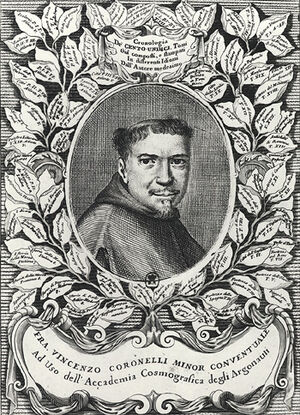Vincenzo Coronelli (nonfiction)
Vincenzo Coronelli (August 16, 1650 – December 9, 1718) was a Franciscan friar, cosmographer, cartographer, publisher, and encyclopedist known in particular for his atlases and globes. He spent most of his life in Venice.
Vincenzo Coronelli was born, probably in Venice, August 16, 1650, the fifth child of a Venetian tailor named Maffio Coronelli. At ten, Vincenzo was sent to the city of Ravenna and was apprenticed to a xylographer.
In 1663 he was accepted into the Conventual Franciscans, becoming a novice in 1665. At age sixteen he published the first of his one hundred forty separate works. In 1671 he entered the Convent of Saint Maria Gloriosa dei Frari in Venice, and in 1672 Coronelli was sent by the order to the College of Saint Bonaventura and Saints Apostoli in Rome where he earned his doctor’s degree in theology in 1674. He excelled in the study of both astronomy and Euclid.
A little before 1678, Coronelli began working as a geographer and was commissioned to make a set of terrestrial and celestial globes for Ranuccio II Farnese, Duke of Parma. Each finely crafted globe was five feet in diameter (c. 175 cm) and so impressed the Duke that he made Coronelli his theologian.
Coronelli's renown as a theologian grew and in 1699 he was appointed Father General of the Franciscan order.
Cardinal César d'Estrées, friend and adviser to Louis XIV and ambassador to Rome, saw the Duke of Parma’s globes and invited Coronelli to Paris in 1681 to construct a pair of globes for the Most Christian King. Coronelli moved to the French capital in 1681, where he lived for two years. Each globe was composed of spindles of bent timber about ten feet long and four inches broad at the equator. This wood was then coated with a layer of plaster about an inch thick and covered in a layer of strong unfinished fabric. This was then wrapped in a quarter-inch layer of two very fine fabrics which provided backing for the painted information of the globes. These globes, measuring 384 cm in diameter and weighing approximately 2 tons, are displayed in the Bibliothèque nationale François Mitterrand in Paris. The globes depicted the latest information of French explorations in North America, particularly the expeditions of René-Robert Cavelier, Sieur de La Salle.
Due to his renown he worked in various European countries in the following years, permanently returning to Venice in 1705. In Venice he started his own cosmographical project and published the volumes of Atlante Veneto. In his home city he founded the very first geographical society, the Accademia Cosmografica degli Argonauti. He also held the position of Cosmographer of the Republic of Venice. Later six volumes of the Biblioteca Universale Sacro-Profana were published by Coronelli. This was a kind of encyclopedia, its compiled entries were ordered alphabetically.
Coronelli died at the age of 68 in Venice, having created hundreds of maps in his lifetime.
In the News
Fiction cross-reference
Nonfiction cross-reference
External links:
- Vincenzo Coronelli @ Wikipedia

